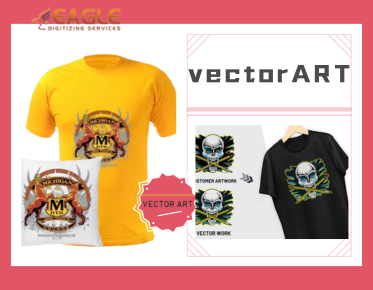Digitizing Color Photos for Embroidery: A Complete Guide
Digitizing a color photo for embroidery transforms your cherished memories into tangible, textured art. This process allows you to stitch detailed and vibrant images onto fabric, turning ordinary photos into extraordinary embroidered masterpieces. Whether it's a beloved family portrait or a stunning landscape, embroidery adds a unique, personal touch.
The Benefits of Turning Photos into Embroidery
Embroidery digitizing offers numerous benefits. It preserves memories in a durable, tactile form that can be passed down through generations. Embroidered photos make excellent gifts, home decor, and even clothing embellishments. Additionally, it provides a creative outlet, blending technology with traditional craftsmanship.
Understanding the Basics
What is Embroidery Digitizing?
Embroidery digitizing is the process of translating a digital image into a format that an embroidery machine can understand. This involves creating a map of stitches that replicates the photo on fabric. It requires specialized software and an understanding of embroidery techniques to achieve high-quality results.
Key Terms You Need to Know: Stitch Types, Hoops, and Stabilizers
Familiarize yourself with essential embroidery terms:
● Stitch Types: Different stitches create various textures. Common types include satin, fill, and running stitches.
● Hoops: Frames that hold the fabric taut during embroidery.
● Stabilizers: Materials placed under the fabric to prevent stretching and distortion during stitching.
Choosing the Right Photo
Tips for Selecting the Best Photo
Choose photos with clear details and good contrast. Simpler images with defined edges and fewer colors work best for embroidery. Portraits, animals, and landscapes are popular choices.
Importance of High-Resolution Images
High-resolution images ensure better detail and accuracy in the embroidery. Low-resolution photos can result in pixelation and loss of detail, making the embroidery look blurry and less defined.
How to Avoid Common Photo Selection Mistakes
Avoid photos with intricate backgrounds or excessive detail that can complicate the digitizing process. Ensure the main subject is well-lit and centered, and check that the image isn’t too dark or overly saturated.
Preparing Your Photo
Cleaning Up Your Photo with Basic Editing
Use photo editing software to clean up your image. Remove any blemishes, distractions, or unwanted elements. This helps focus on the main subject and ensures a cleaner embroidery result.
Adjusting Brightness, Contrast, and Colors
Adjust the brightness and contrast to make the details more prominent. Tweak the colors to ensure they’re vibrant and distinct, which will translate better in embroidery threads.
Cropping and Resizing for Optimal Results
Crop your photo to focus on the most important parts. Resize it to match the dimensions of your intended embroidery area. Keeping the aspect ratio consistent prevents distortion.
Essential Tools and Software
Overview of Popular Embroidery Digitizing Software
Several software options are available for embroidery digitizing, such as Wilcom, Hatch, and Brother PE-Design. Each offers unique features catering to different skill levels and requirements.
Free vs. Paid Software: Which is Right for You?
Free software like Ink/Stitch can be a good starting point, but paid options often provide advanced tools and better support. Choose based on your budget and the complexity of your projects.
Setting Up Your Software for the First Time
Install your chosen software and familiarize yourself with its interface. Set up preferences and templates for your machine and projects. Follow any tutorials provided to understand the basic functionalities.
Getting Started with Digitizing
Importing Your Photo into the Software
Open your digitizing software and import the photo you’ve prepared. Most software will allow you to adjust the image within the program before you begin tracing.
Setting Up Your Embroidery Design Canvas
Create a new project and set your canvas size to match the embroidery hoop you’ll be using. Ensure your photo is positioned correctly within this space.
Understanding Layers and Their Importance in Digitizing
Using layers helps manage different parts of your design. Separate elements like the background, main subject, and fine details into different layers to make the digitizing process more organized and flexible.
Tracing Your Photo
Manual Tracing vs. Auto-Digitizing: Pros and Cons
Manual tracing offers precision and control, allowing you to define each stitch. Auto-digitizing can save time but may not capture intricate details as accurately. Choose based on the complexity of your photo and your skill level.
Using the Pen Tool for Precision
The pen tool is crucial for manual tracing. It allows you to plot points along the edges of your photo, creating a path that the software will convert into stitches. Adjust these points for smooth curves and accurate outlines.
Creating Outlines and Borders for Your Design
Outlines and borders define the main shapes in your design. Use them to separate different elements and add emphasis. They help ensure the main features stand out in the final embroidery.
Working with Colors
Reducing the Number of Colors in Your Photo
Simplify your photo by reducing the number of colors. Too many colors can complicate the digitizing process and result in a less cohesive design. Focus on the most important colors that define the subject.
Choosing the Right Thread Colors
Select thread colors that closely match those in your photo. Consider the availability of thread colors and how they will appear on your chosen fabric. Test small samples if necessary.
Using Color Blending Techniques for Realistic Effects
Blend colors to create gradients and realistic effects. Overlapping stitches of different colors can mimic the subtle transitions found in photos, adding depth and dimension to your embroidery.
Defining Stitch Types
Overview of Common Stitch Types: Satin, Fill, and Running Stitches
Each stitch type serves a different purpose:
● Satin Stitches: Perfect for outlines and borders.
● Fill Stitches: Ideal for larger areas and backgrounds.
● Running Stitches: Great for fine details and intricate lines.
When to Use Each Stitch Type
Use satin stitches for bold outlines, fill stitches for solid areas, and running stitches for details and texture. Combining different stitches adds variety and interest to your design.
Creating Texture with Different Stitches
Experiment with different stitch types to create texture. Varying stitch direction, length, and density can replicate the textures found in your photo, making the embroidery more dynamic.
Managing Stitch Density
Importance of Stitch Density in Embroidery
Stitch density affects the look and feel of your embroidery. Too high a density can make the fabric stiff, while too low can leave gaps. Finding the right balance is crucial for a professional finish.
Adjusting Stitch Density for Different Fabrics
Different fabrics require different stitch densities. Heavier fabrics can handle higher densities, while lighter fabrics need lower densities to avoid puckering. Test on scrap fabric to find the optimal settings.
Avoiding Common Density Problems
Ensure your design doesn’t have overly dense areas that could cause thread breaks or fabric damage. Use the software’s simulation tools to check for potential issues before stitching.
Adding Details and Textures
Incorporating Fine Details into Your Design
Fine details bring your embroidery to life. Use small stitches and careful placement to capture the intricate elements of your photo. Patience and precision are key.
Using Specialty Stitches for Unique Textures
Specialty stitches, like French knots or chain stitches, add unique textures. Incorporate these into your design to create standout elements that draw the eye.
Adding Shading and Highlights for Depth
Shading and highlights add depth and realism. Use lighter and darker threads to create these effects, enhancing the three-dimensional appearance of your embroidery.
Working with Fonts and Text
Adding Text to Your Embroidery Design
Text can personalize your embroidery. Use the software’s text tool to add names, dates, or messages. Position the text carefully to complement your design.
Choosing the Right Fonts for Embroidery
Select fonts that are clear and readable when stitched. Avoid overly intricate fonts that might not translate well to thread. Simple, bold fonts work best.
Tips for Digitizing Small Text
Small-sized text requires careful digitizing to remain legible. Use a high stitch density and consider the thread thickness. Test stitch small samples to ensure clarity.
Testing Your Design
Running a Test Stitch Out
Always run a test stitch on a similar fabric before committing to the final piece. This helps identify any issues with the design or stitching process.
Analyzing the Test Results for Errors
Examine the test stitch for any errors, such as gaps, overlaps, or incorrect colors. Note any issues and make adjustments in the software.
Making Necessary Adjustments to Your Design
Based on your test stitch, adjust the design as needed. Fine-tune stitch types, density, and colors to perfect the final embroidery.
Hooping and Stabilizing Your Fabric
Choosing the Right Hoop for Your Project
Select a hoop that fits your fabric and design size. A good hoop holds the fabric taut without distorting it, ensuring accurate stitching.
Types of Stabilizers and Their Uses
Stabilizers provide support and prevent distortion. Choose the right type for your fabric and design, whether it’s tear-away, cut-away, or water-soluble.
Proper Hooping Techniques to Avoid Fabric Distortion
Hoop your fabric carefully to avoid stretching or puckering. Ensure the fabric is smooth and evenly tensioned within the hoop.
Exporting Your Design
Exporting to the Correct File Format
Export your design in a format compatible with your embroidery machine. Common formats include PES, DST, and EXP. Check your machine’s manual for the correct format.
Ensuring Compatibility with Your Embroidery Machine
Ensure your design settings match your machine’s capabilities. This includes hoop size, stitch density, and thread colors. Double-check compatibility before starting the final stitch.
Tips for Saving and Organizing Your Designs
Organize your designs by project or category. Use descriptive file names and folders to keep everything easily accessible. Back up your designs to avoid loss.
Troubleshooting Common Issues
Fixing Gaps and Overlaps in Your Design
Gaps and overlaps can ruin the look of your embroidery. Adjust stitch paths and densities to ensure smooth transitions between elements.
Resolving Thread Breaks and Tangles
Thread breaks and tangles can be caused by incorrect tension or poor thread quality. Ensure your machine is properly threaded and maintained. Use high-quality threads to reduce these issues.
Addressing Fabric Puckering and Distortion
Fabric puckering can result from improper hooping or excessive stitch density. Adjust your hooping technique and reduce density in problem areas.
This structured guide equips embroidery enthusiasts with the knowledge and skills to transform color photos into captivating artwork. By understanding the fundamentals, mastering essential techniques, and leveraging advanced strategies, readers can embark on their embroidery digitization journey with confidence and creativity.



